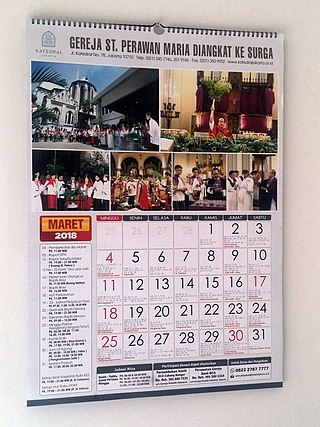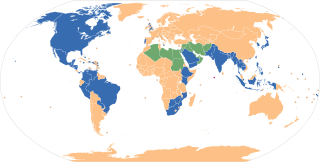
A calendar is a system of organizing days. This is done by giving names to periods of time, typically days, weeks, months and years. A date is the designation of a single and specific day within such a system. A calendar is also a physical record of such a system. A calendar can also mean a list of planned events, such as a court calendar, or a partly or fully chronological list of documents, such as a calendar of wills.

The Hebrew calendar, also called the Jewish calendar, is a lunisolar calendar used today for Jewish religious observance and as an official calendar of Israel. It determines the dates of Jewish holidays and other rituals, such as yahrzeits and the schedule of public Torah readings. In Israel, it is used for religious purposes, provides a time frame for agriculture, and is an official calendar for civil holidays alongside the Gregorian calendar.
A leap year is a calendar year that contains an additional day compared to a common year. The 366th day is added to keep the calendar year synchronized with the astronomical year or seasonal year. Because astronomical events and seasons do not repeat in a whole number of days, calendars that have a constant number of days in each year will unavoidably drift over time with respect to the event that the year is supposed to track, such as seasons. By inserting ("intercalating") an additional day or month into some years, the drift between a civilization's dating system and the physical properties of the Solar System can be corrected.
The International Fixed Calendar is a proposed calendar reform designed by Moses B. Cotsworth, first presented in 1902. The International Fixed Calendar divides the year into 13 months of 28 days each. A type of perennial calendar, every date is fixed to the same weekday every year. Though it was never officially adopted at the country level, the entrepreneur George Eastman instituted its use at the Eastman Kodak Company in 1928, where it was used until 1989. While it is sometimes described as the 13-month calendar or the equal-month calendar, various alternative calendar designs share these features.

The Roman calendar was the calendar used by the Roman Kingdom and Roman Republic. Although the term is primarily used for Rome's pre-Julian calendars, it is often used inclusively of the Julian calendar established by the reforms of the Dictator Julius Caesar and Emperor Augustus in the late 1st century BC.
Reform of the date of Easter refers to proposals to change the date for the annual celebration of Easter. These proposals include setting a fixed date or agreeing between Eastern and Western Christendom a common basis for calculating the date of Easter so that all Christians celebrate the Festival on the same day. As of 2023, no such agreement has been reached.

A week is a unit of time equal to seven days. It is the standard time period used for short cycles of days in most parts of the world. The days are often used to indicate common work days and rest days, as well as days of worship. Weeks are often mapped against yearly calendars, but are typically not the basis for them, as weeks are not based on astronomy.
The World Calendar is a proposed reform of the Gregorian calendar created by Elisabeth Achelis of Brooklyn, New York in 1930.

As a moveable feast, the date of Easter is determined in each year through a calculation known as computus. Easter is celebrated on the first Sunday after the Paschal full moon, which is the first full moon on or after 21 March. Determining this date in advance requires a correlation between the lunar months and the solar year, while also accounting for the month, date, and weekday of the Julian or Gregorian calendar. The complexity of the algorithm arises because of the desire to associate the date of Easter with the date of the Jewish feast of Passover which, Christians believe, is when Jesus was crucified.
Dominical letters or Sunday letters are a method used to determine the day of the week for particular dates. When using this method, each year is assigned a letter depending on which day of the week the year starts.
Calendar reform or calendrical reform is any significant revision of a calendar system. The term sometimes is used instead for a proposal to switch to a different calendar design.
The positivist calendar was a calendar reform proposal by Auguste Comte (1798–1857) in 1849. Revising the earlier work of Marco Mastrofini, or an even earlier proposal by "Hirossa Ap-Iccim", Comte developed a solar calendar with 13 months of 28 days, and an additional festival day commemorating the dead, totalling 365 days.
A leap week calendar is a calendar system with a whole number of weeks in a year, and with every year starting on the same weekday. Most leap week calendars are proposed reforms to the civil calendar, in order to achieve a perennial calendar. Some, however, such as the ISO week date calendar, are simply conveniences for specific purposes.
The Symmetry454 calendar (Sym454) is a proposal for calendar reform created by Irv Bromberg of the University of Toronto, Canada. It is a perennial solar calendar that conserves the traditional month pattern and 7-day week, has symmetrical equal quarters in 82% of the years in its 293-year cycle, and starts every month on Monday.
The Pax calendar was invented by James A. Colligan, SJ in 1930, as a perennializing reform of the annualized Gregorian calendar.
The Gregorian calendar is the calendar used in most parts of the world. It went into effect in October 1582 following the papal bull Inter gravissimas issued by Pope Gregory XIII, which introduced it as a modification of, and replacement for, the Julian calendar. The principal change was to space leap years differently so as to make the average calendar year 365.2425 days long, more closely approximating the 365.2422-day 'tropical' or 'solar' year that is determined by the Earth's revolution around the Sun.
Armelin's calendar was developed around 1887 by French astronomer Gaston Armelin, who developed a twelve-month calendar in which the year of 364 days was divided into four equal quarters of 91 days.
The Hanke–Henry Permanent Calendar (HHPC) is a proposal for calendar reform. It is one of many examples of leap week calendars, calendars that maintain synchronization with the solar year by intercalating entire weeks rather than single days. It is a modification of a previous proposal, Common-Civil-Calendar-and-Time (CCC&T). With the Hanke–Henry Permanent Calendar, every calendar date always falls on the same day of the week. A major feature of the calendar system is the abolition of time zones.
A perennial calendar is a calendar that applies to any year, keeping the same dates, weekdays and other features.

Alexander Philip was a Scottish solicitor and campaigner for calendar reform. He was elected a Fellow of the Royal Society of Edinburgh in 1913